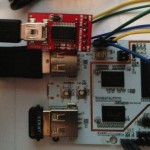pcDuino U-Boot – Part 3 TAGS: Cooking | custom boot | U-Boot In Part 1 and Part 2 of this series of posts I outlined the attempts I have made at using U-Boot to control the booting of the pcDuino. Specifically, I …Continue reading →
April 25, 2025
pcDuino U-Boot – Part 1 TAGS: Cooking | debug | serial | TeraTerm | U-Boot This evening I decided it was time to check out the boot loader and boot command options on the pcDuino. To access the serial port on the J5 debug port …Continue reading →
Setting pcDuino Display Resolution TAGS: Cooking | fex | HDMI One of the things I had noted earlier was that the HDMI output resolution is fixed at 720p (1280×720) and there was no documented way of setting a new resolution. …Continue reading →
pcDuino – I2C Test TAGS: Cooking | I2C | Python Today I connected up a my prototype board for an I2C experiment with the pcDuino. Blinky Lights! YouTube video of simple I2C parallel port test using Python.
pcDuino Setup TAGS: Cooking | HDMI Finally some time to get my new pcDuino set up. Connected a USB keyboard, USB mouse to the USB ports. Plugged in to my network, connected the monitor to the …Continue reading →
pcDuino Arrives TAGS: Cooking My pcDuino was deliverd while I was at work. I came home this evening to find the distinctive Sparkfun red box waiting for me. I could not wait to confirm …Continue reading →
pcDuino TAGS: ARM | Beagle Bone | Cooking | Python | Raspberry Pi I was browsing the Sparkfun web site this week and saw they had added the pcDuino as a new product. At $59USD this looked to be an excellent addition to …Continue reading →

